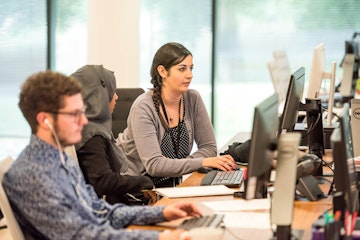Virtual Classroom Tour
Virtual Tour: General Assembly's Online Classroom

![]()
Written By Liz Eggleston

![]()
Written By Liz Eggleston
Course Report strives to create the most trust-worthy content about coding bootcamps. Read more about Course Report’s Editorial Policy and How We Make Money.
Course Report strives to create the most trust-worthy content about coding bootcamps. Read more about Course Report’s Editorial Policy and How We Make Money.
What does General Assembly’s online classroom look like? Which tools will you be using to collaborate remotely? And how can you land a job after graduating from an online General Assembly class? Sarah Favreau, Head of Learning at General Assembly, explains the ins and outs of their online learning experience. And Emily Van Blargen, a General Assembly Career Coach, weighs in with recession-proof job search tips!
Sarah, how did you get into tech and teaching and what does it mean to be the Head of Learning at GA?
I originally got into teaching focused on children, teaching 1st and 3rd graders in NYC. Throughout the course of my career, I’ve had the chance to work with learners of all ages, and I particularly love working with adults like we do at General Assembly, in the space we call “education to employment” - learning with an explicit goal of furthering employment opportunities. As the Head of Learning, I oversee our instruction, instructional design, and education technology, thinking about how each of these pieces work together to ensure that GA’s students have a really purposeful and impactful learning experience.
Emily, tell us about your role at GA!
I’m a Career Coach that works with General Assembly’s NYC Campus. This means, I work with students who enroll in our Immersive Programs (Data Science, UX Design, Software Engineer) both in-course, during the 12 week immersive, and post-course until they land their first break in the field. I work with each student 1:1 to coach them on their job search strategy and ensure their job search materials stand out, and work with students in group setting to cover topics like how to build a portfolio, salary negotiation, behavioral interviewing, and more! I absolutely love what I do - I help individuals unlock their potential to pursue the career of their dreams.
What have you noticed that the most successful students have done as you’ve shifted to remote learning?
Sarah: Live remote learning is a new experience for most learners. We’ve noticed that the most successful remote learners have a combination of tech literacy skills and adaptable mindset. From a tech literacy standpoint, live remote learning requires skills like being able to navigate multiple windows on their computer screen and being able to type quickly enough to keep up with live chat conversations in Slack or Zoom chat. On the mindset front, the first time engaging in a live, remote classroom can be disorienting because it’s a brand new experience, so students often need to learn and evaluate how they learn best online and adapt their approach. We work to help students think through considerations through supports like onboarding calls prior to the class, but we find that the most successful students are reflective about what works for them - they evolve their approach throughout that course and reach out to their instructional and student success team for help along the way!
What’s your advice for students about how to set up their online workspace?
Sarah: Two main considerations can help students in creating an effective online workspace: technology needs and environment needs. Technology needs include making decisions like determining whether an external monitor in addition to their laptop (when possible) would be helpful, if it’s easier for them to use a mouse or the trackpad on their computer, if they are comfortable using headphones during the duration of the course and if so, which kind (earbuds, a headset, etc), and if their internet provides a stable connection or if it would be helpful to have an alternative, like an ethernet cable, available. Environment needs include making sure they are comfortable and set up to be able to focus well, including finding a quiet space where they can focus and considering if they would like to use a Zoom background during meetings.
How do you ensure that remote students won’t miss out on anything that in-person students get?
Sarah: At General Assembly, we use the same approach to design our courses regardless of modality (if they are taught in person or remotely): we decide what students need to be able to do, and we design lessons and activities to accomplish that. While the modality may change, the content and objectives do not, so what our team needs to consider is how to modify the delivery of the activity depending on the modality. Our curriculum and lessons are built from the start to be able to be delivered either in person or remotely: lessons have “teaching tips” built into them that provide guidance for how an instructor could facilitate an activity in person or remotely. On the community and networking front, classroom interactions within a cohort through breakout groups, projects, and community-building activities in the class build important, close connections. We also offer opportunities for students to connect and support each other across cohorts, including through events like Q&A panels with professionals in the field and online SRGs (student resource groups), which create safe spaces where students from across the GA community can come together to discuss experiences, get to know one another, and share resources that others might find useful.
What does the Remote Classroom look like at General Assembly? What is MyGA?
Sarah: General Assembly uses a blended learning approach, which combines self-paced online learning and live instructor-led learning, in both our in person and remote courses. Students complete a series of self-paced elearning modules on our proprietary platform, myGA, prior to the course and at key points throughout the course to introduce foundational topics to ensure that students have a common baseline entering the instructor-led sessions and to provide students with multiple exposures to new content. Then, the instructor-led sessions are able to focus on discussing, processing, and practicing information and skills.
How do you use tools like Zoom and Slack in the classroom?
Sarah: Zoom and Slack are the very core of our remote classroom experience! Our instructors use them seamlessly, in tandem, to provide instruction and enable live communication. Zoom allows instructors to lead the class, share their (or a student’s) screen, and divide the class into breakout rooms for work in small groups. At the same time, classes have Slack open to conduct “checks for understanding” (asking quick questions to the whole class to gauge how well they understand a topic), share materials, conduct brainstorming, and much more. Finally, classes also incorporate other tools depending on their content. For example, many of our classes use a tool called Miro for virtual collaborative whiteboarding. This video shows what it looks like for GA classes to use Zoom, Slack, Miro and more in action for our live remote classes!
SEI Cohort using slack during class time:
SEI cohort in an Outcomes Workshop (Intro to Portfolios):
How do General Assembly students know where they are in the curriculum?
Sarah: Our immersive classes (both in person and remote) use Google calendars to help students have a detailed view of upcoming topics and activities.
How do students communicate with each other and with their instructors online? Will online students work with one another?
Sarah: Zoom and Slack are our main methods of communication for remote classes. Zoom enables real-time, face-to-face communication, including full class sessions led by instructors, small breakout groups during class, and student collaboration and 1:1 teaching assistant support during project working sessions and after-hours in evenings and on weekends. Student collaboration and interaction is key throughout these experiences - both during formal instructor-led sessions and when students collaborate with each other on group projects.
What’s the biggest lesson your team has learned in the past few months? Have you made any tweaks or changes?
Sarah: One of our biggest observations is that remote learning requires more explicit planning, communication, and expectations. In-person experiences have the benefit of spontaneous, organic interactions. Replicating that support, connection, and community online is possible, but it requires intention! For example, conducting 1:1 onboarding sessions help students clarify what their goals are for the course and think through what to expect, which helps them be mentally prepared to start learning on day 1. Within the class, we’ve found that explicitly discussing as a group how to interact in the online setting is helpful (what do you do if you have a question? When should you use Slack vs Zoom chat?).
Are GA instructors able to have unique teaching styles? How is that made possible through the remote classroom?
Sarah: Yes, every GA instructor has their own unique teaching style! Just as they are able to bring their style to life in the classroom on our campus, they each bring their own flair to classes conducted via Zoom. While all instructors are focused on helping GA students master the course content, they infuse each lesson with their own examples based on their professional experience, fun touches unique to their class (like entertaining icebreaker questions to kick off a class session), and their own personality - from jokes to inspiration to warmth and support.
General Assembly has a great history of getting students jobs – how do you help students remotely in the job search?
Emily: Navigating a job search remotely, as opposed to in person, has slightly changed the process of landing a job. Networking and the interview process are where I’ve seen the biggest shifts and where I’ve tweaked my coaching the most. For some individuals, networking remotely is preferred because you can join digital communities (like Techqueria, Blacks in Technology, and Products by Women) and make a lot of connections in a short amount of time. For extroverts that enjoyed the in-person experience of going to networking events, it was a tougher transition. Luckily, as the world has moved to remote, so has the networking event format! Now, extroverts are able to find digital Meetups that use Zoom break out rooms to recreate that in-person networking experience. Coaches at General Assembly are focused on identifying how the job search has changed and tweak our coaching accordingly. When it comes to interviewing remotely, job seekers gain the opportunity to have notes in front of them and feel more prepared, but have to actively think about body language and eye contact in a different way than they did in person. To “look someone in the eye” on a video call means you must focus your attention on the camera instead of the image of the person.
Are your students landing jobs during the pandemic?
Emily: Yes! I will say, because unemployment rates have increased since the pandemic, the job market has become even more competitive. The good news is, we prepare our students for this. Job seeking always requires grit, patience, resilience, and creativity. Our grads know those values are important now, more than ever, and utilize those values to push through and land jobs! The creativity piece has been extremely important in our students' success. Finding ways to stand out as an applicant, create and grow their professional network and remain active in the field is what allows them to land a job in this landscape.
Do you have any recession-proof job-hunting tips for recently graduated students? What’s the best advice you’ve heard from a student or instructor about how to get a job after graduating from a remote bootcamp?
Emily: Network, network, network! The advice I live by and constantly hear from others is: utilize/grow your network and find ways to stand out to potential employers. Networking is beneficial for a number of reasons:
When it comes to finding ways to stand out to potential employers, the ideas are endless. One of my favorite examples of this, shared by a GA alum who landed a job because of it is: when you find a job opening that really excites you, take the extra step to create a project that aligns with that company’s product or mission and share that as part of your application! It shows the company how invested you are in joining their team.
Are you seeing an influx of demand from folks who have lost their jobs in the service industries? How can those types of students take advantage of a program like General Assembly?
Emily: GA was already working with many students interested in career pivoting away from the service industry prior to the job market this pandemic has created. We have definitely seen an increase in interest from these folks since the world has shifted due to COVID-19. My advice to anyone considering a career pivot is this: Do your research first! Start small, by exploring different classes and workshops in different subject areas. It is 100% possible to transition from the service industry to the tech industry, so long as you find a specific area of interest (like Software Engineering, Product Management, or UX Design) that suits your interests and skills. GA’s Admissions Team is great at helping individuals uncover what area suits them best, and GA offers plenty of free events that allow you to get a taste of what different jobs in tech are like.
This is the #1 question we get right now – Why is this a good time for someone to make a career change into tech?
Emily: We have seen the tech industry continue to grow, year over year — but why make the career switch now, during a pandemic? Because this is a time that is pushing the workforce to innovate digitally! The skills that are most in-demand in this period of digital transformation are tech skills! Specifically, design, engineering and data. These skills are building the tools and services companies in every industry need to thrive during this time. I am personally very excited to see how this period of digital transformation continues to push companies to innovate, creating more jobs for individuals working in the tech space.
Find out more and read General Assembly reviews on Course Report. This article was produced by the Course Report team in partnership with General Assembly.

Liz Eggleston, CEO and Editor of Course Report
Liz Eggleston is co-founder of Course Report, the most complete resource for students choosing a coding bootcamp. Liz has dedicated her career to empowering passionate career changers to break into tech, providing valuable insights and guidance in the rapidly evolving field of tech education. At Course Report, Liz has built a trusted platform that helps thousands of students navigate the complex landscape of coding bootcamps.










Sign up for our newsletter and receive our free guide to paying for a bootcamp.
Just tell us who you are and what you’re searching for, we’ll handle the rest.
Match Me